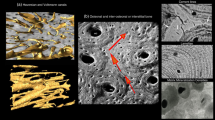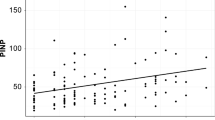Summary
□Background and Method: In an additional bone density measurement protocol to the European Vertebral Osteoporosis Study (EVOS) separate spongious and cortical density measurements (sQCT) were carried out at the first 3 lumbar vertebrae in 293 volunteers (92 men and 201 women) in 3 Berlin regional centers.
□Results: The spongious mineral density decreases from proximal to distal (L1 to L3), the cortical density increases from proximal to distal, mainly in men. Men showed no significant decrease of cortical density and a lower decrease of spongious density with age compared to women. A comparison of bone mineral density with vertebral height indices of McCloskey/Kanis, Eastell/Melton and Felsenberg showed significant differences of spongious density between a group with normal vertebral height and a group with at least one pathologically degraded vertebra. Individuals with osteoporosis according to the WHO-definition showed a higher prevalence of vertebral deformities. No significant loss of cortical density was observed in these people.
Similar content being viewed by others
Literatur
Barnett E, Nordin BEC. The radiological diagnosis of osteoporosis: a new approach. Clin Radiol 1960;11:166–74.
Brenner RA, Edwards WT, Fay LA, Fortino MD, Spadaro JA, Werner FW. Cortical and trabecular bone contribute strength to the osteopenic distal radius. J Orthop Res 1994;12:211–8.
Cann CE. Quantitative CT for determination of bone mineral density: a review. Radiology 1988;166:509–22.
Consensus development conference: diagnosis, prophylaxis and treatment of osteoporosis. Am J Med 1993;94:646–50.
Cooper C, O’Neill T, Silman A. The epidemiology of vertebral fractures. European Vertebral Osteoporosis Study Group. Bone 1993;14(Suppl):89–97.
Cummings SR, Black DM, Rubin SM. Lifetime risk of hip, Colles’, or vertebral fracture and coronary heart disease among white postmenopausal women. Arch Intern Med 1989;149:2445–8.
Cummings SR, Black DM, Nevitt MC et al. Bone density at various sites for prediction of hip fractures. Lancet 1993;341:72–5.
Eastell R, Cedel SL, Wahner HW, Riggs BL, Melton LJ. Classification of vertebral fractures. J Bone Miner Res 1991;6:207–15.
Felsenberg D, Kalender WA, Banzer D et al. Quantitative computertomographische Knochenmineralgehaltsbe-stimmung. Fortschr Röntgenstr 1988;148,4:431–6.
Felsenberg D, Oles M, Burgis E. Protocol for the standardization of x-rays for vertebral deformity measurements. Berlin: Steglitz Press, 1990.
Gundersen HJ, Holme K, Melsen F, Mosekilde L, Sörensen S, Vesterby A. Biologically meaningful determinants of the in vitro strength of lumbar vertebrae. Bone 1991; 12:219–24.
Hansen M, Overgaard K, Riis B, Christiansen C. Role of peak bone mass and bone loss in postmenopausal osteoporosis: 12 year study. BMJ 1991;303:961–4.
Hui SL, Slemenda CS, Johnston CC. Age and bone mass as predictors of fracture in a prospective study. J Clin Invest 1988;81:1804–9.
Kalender WA, Perman WH, Vetter JR, Klotz E. Evaluation of a prototype dual-energy computer tomography aparatus. I. Phantom studies. Med Phys 1986;13:334–9.
Kalender WA, Felsenberg D, Genant HK, Fischer M, Dequeker J, Reeve J. The European Spine Phantom — a tool for standardization and quality control in spinal bone mineral measurements by DXA and QCT. Eur J Radiol 1995;20:83–92.
Kanis JA, Pitt F. Epidemiology of osteoporosis. Bone 1992;13(Suppl):S7-S15.
Kanis JA and the WHO Study Group. Assessment of fracture risk and its application to screening for postmenopausal osteoporosis: synopsis of a WHO report. Osteoporosis Int 1994;4:368–81.
Louis O, Luypaert R, Kalender WA, Osteaux M. Reproducibility of CT bone densitometry: operator versus automated ROI definition. Eur J Radiol 1988;8:82–4.
McCloskey EV, Spector TD, Eyres KS et al. The assessment of vertebral deformity: a method for use in population studies and clinical trials. Osteoporosis Int 1993;3:138–47.
O’Neill TW, Varlow J, Felsenberg D et al. Variation in vertebral height ratios in population studies. J Bone Miner Res 1994;9:1895–907.
Turner RT, Riggs BL, Spelsberg TC. Skeletal effects of estrogen. Endocr Rev 1994;15:275–300.
Werner J, Andresen R, Schober HC, Banzer D, Schmitz KP. The role of cortical bone mineral density for osteoporotic vertebral fractures. Bone 1997;20:44S.
Wieland EU. Bestimmung der Wirbelkörpergeometrie zur Diagnose der Osteoporose. Freie Universität Berlin, 1993. Dissertation.
Author information
Authors and Affiliations
Corresponding author
Additional information
Die Arbeit wurde im Rahmen der europäischen Studie zur vertebralen Osteoporose (EVOS) gefördert durch die Europäische Union und den Bundesminister für Bildung, Wissenschaft, Forschung und Technologie.
Rights and permissions
About this article
Cite this article
Banzer, D., Fabian, C., Andresen, R. et al. Knochendichte von Spongiosa und Kortikalis der Lendenwirbelsäule. Med Klin 93 (Suppl 2), 56–65 (1998). https://doi.org/10.1007/BF03042000
Issue Date:
DOI: https://doi.org/10.1007/BF03042000




